Madikwe is a wilderness that boasts a striking collection of luxury lodges. It is an ideal safari destination for families wishing to enjoy a Big Five safari in South Africa without malaria risk. Some lodges focus on child-friendly activities and provide a comprehensive adventure in the African wilderness.
Need Advice?The reserve in the North West province of South Africa is in an area of the country located on the transition zone between the drier western reaches and the higher rainfall areas to the east.

Madikwe lies to the south of Botswana with the Limpopo river creating a natural border. It was created by merging low-yield cattle farms into a high-yield conservation area. The project focused on bringing much-needed jobs to the region while protecting the unique wilderness and the species that grace it. Madikwe is a model for innovators who seek to balance conservation and the needs of an ever-growing human population.
Spoil yourself and your loved one with stays at remote lodges in pristine natural settings. This honeymoon package offers an outstanding balance between activity and private time.
This two-week family adventure combines a safari in Madikwe with a stay at Sun City before venturing South to the Garden Route region and Cape Town.
Madikwe is home to several safari lodges with varying degrees of luxury, ideal for a malaria-free family safari in South Africa.
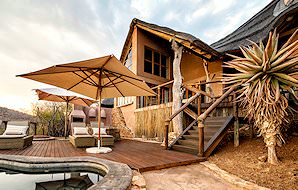
Impodimo is Built on a rugged dolomite ridge with sweeping views of Madikwe; the lodge offers luxury safaris in this malaria-free game reserve.
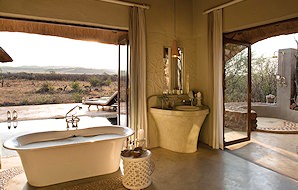
Madikwe Hills can accommodate twenty-four guests in large suites, each with a private plunge pool. Wooden walkways connect the secluded suites to the main lodge area.
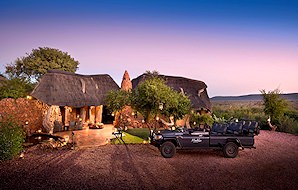
Madikwe safari lodge has three small camps Lelapa, Kopano and Dithaba. Each caters to specific travelers, whether couples on honeymoon or families enjoying an African Safari.
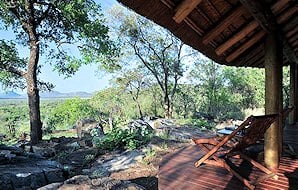
Buffalo Ridge Safari Lodge is a family-owned bush camp and eco-lodge with a stunning setting on Tweedepoort Ridge with views of the surrounding wooded hills and plains.
This safari area boasts a large lion population - spotting the king of mammals on your game drives is a near certainty. A fact that will undoubtedly provide excitement for children of all ages. It is a very safe experience conducted by rangers and trackers with intimate knowledge of Lion behavior.
Unlike many other parks and reserves, Madikwe doesn't have a "keep to the designated road's policy," which means that if the animals aren't coming to you, rangers will take you off the road to enhance the possibility of great sightings to see. Going off-road will add a dimension to the experience for the entire family.
Madikwe is the fifth-largest reserve in South Africa and encompasses a diversity of biomes, which include bushveld, savanna grassland, and riverine forest. Each of these habitats provides unique photographic opportunities.
Experiences in the Madikwe Game Reserve focus on interacting with the natural environment.
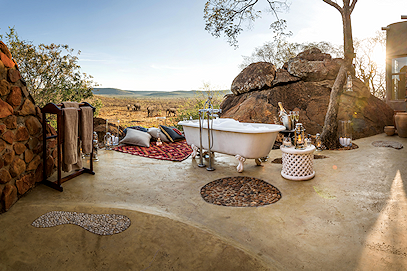
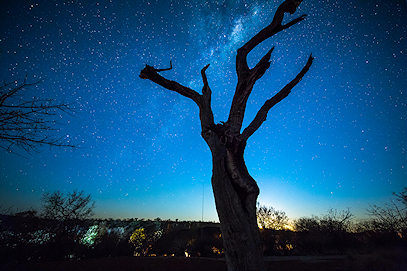
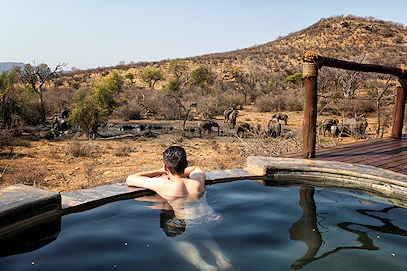
Guests to Madikwe Game Reserve must travel to the northern reaches of South Africa. Traveling to Madikwe is most accessible from OR Tambo International Airport in Johannesburg. Upon arrival at the airport, we will assist guests in transferring to a charter flight which takes visitors directly to the game reserve in the North-West province.
If Madikwe is not your itinerary's first destination, you are transferred to the reserve via a private, air-conditioned vehicle. It is approximately 150km from popular destinations such as the Sun City Resort. The drive through the North West offers visitors an excellent opportunity to spot wildlife, as game farms are prominent in the area.
You can visit Madikwe year-round. The animals do not undertake any significant migrations; no matter how thick or thin the vegetation is, they will be seen somewhere in the area. For birders, however, the rainy summer season is the best time to visit, as the migratory and local birds are present.
The dry winter months make spotting wildlife a bit easier as the vegetation thins, and the cooler temperatures during the day are great for outdoor activities such as hiking and bush walks. The summers in Madikwe can become hot, but it is not as humid as parks situated closer to the coastal regions.
Madikwe Game Reserve has its roots in the political history of South Africa. During the apartheid years, the South African government created self-governing homelands for indigenous people - one of these was an area named Bophuthatswana. Economists realized that the area would serve its people better economically if they transformed the cattle farms into a wildlife reserve. This process started in 1991. The result is a model for what conservation can do. Bop Parks, as it was known, established a model where the Bop Government managed the land and wildlife while the private sector built lodges and the local community received employment and income.
Bop Parks launched Operation Phoenix in 1991 and started re-populating the reserve with animals that used to occur here. By 1997, more than 8 000 animals were re-introduced to the 75 000 hectare reserve.
All the Big Five animals occur here. Enormous herds of elephants and buffalo are commonplace. The reserve has both the black and white rhinoceros, with the white rhino relatively common and the much rarer black rhino seen occasionally. Lions are frequently seen, and there is also an excellent chance to spot the elusive leopard. A highlight of this wilderness is the wild dogs that are now common in the reserve and have become habituated to the game viewers. It allows for fantastic close-up photos of this endangered animal. Another animal not seen often elsewhere is the brown hyena.
Madikwe boasts 66 large mammal species. Cheetahs occur, and there is always a chance of spotting the fastest land mammal in the world. Plenty of giraffes and zebra make for brilliant photography against majestic backdrops. Hippos are common, as are antelope such as springbok, gemsbok, eland, and sable. You might come across a black-backed jackal or even spot the rare pangolin. Birds are abundant, with more than 300 species recorded; notable species are the yellow-billed hornbill and lilac-breasted roller.
The Madikwe Game Reserve encompasses a diverse range of terrains which include mountains, seasonal wetlands, bushveld, savanna, Kalahari veld, and thornveld, to name but a few. The reserve is still very young, and the farming and hunting activities on the land severely damaged the natural ecosystems and vegetation that occurred naturally. The reserve's success with Operation Phoenix has seen a miraculously quick recovery in terms of both animal and vegetative species that belong in the area.
The park is home to various geological formations that, over millions of years, created a multifaceted basis on which the different vegetation types grow. The terrain can, to a large extent, be classified as open grasslands and bushveld, which include mixed bushveld, Kalahari bushveld, arid sweet bushveld, and turf thornveld. Madikwe and the nearby Pilanesberg Game Reserve have teamed up to conserve the natural environment further by creating a natural corridor between the reserves.
If you are traveling with children, you can rest assured knowing that the malaria-free reserve has their best interest in mind. Specially trained expert guides take kids on kiddies' game drives. Lodges provide educational entertainment and fun activities such as painting and arts and crafts. If you are not traveling with children, a more secluded and intimate experience is offered where guests can enjoy the scenery from their private deck and relax in their private plunge pool.
Game drives at Madikwe are the best to cover territory and view the abundant wildlife. These drives are conducted by experienced rangers who share their intimate knowledge of the animals and the landscape with guests. There are also opportunities to interact with local villages and learn more about the area's indigenous people. Short walks and bush breakfasts are available at some lodges, an excellent way for birding enthusiasts to maximize sightings.